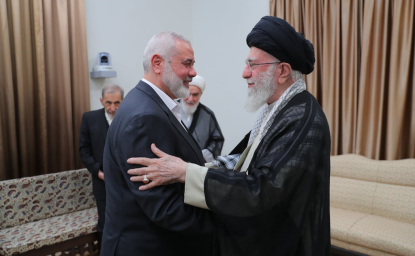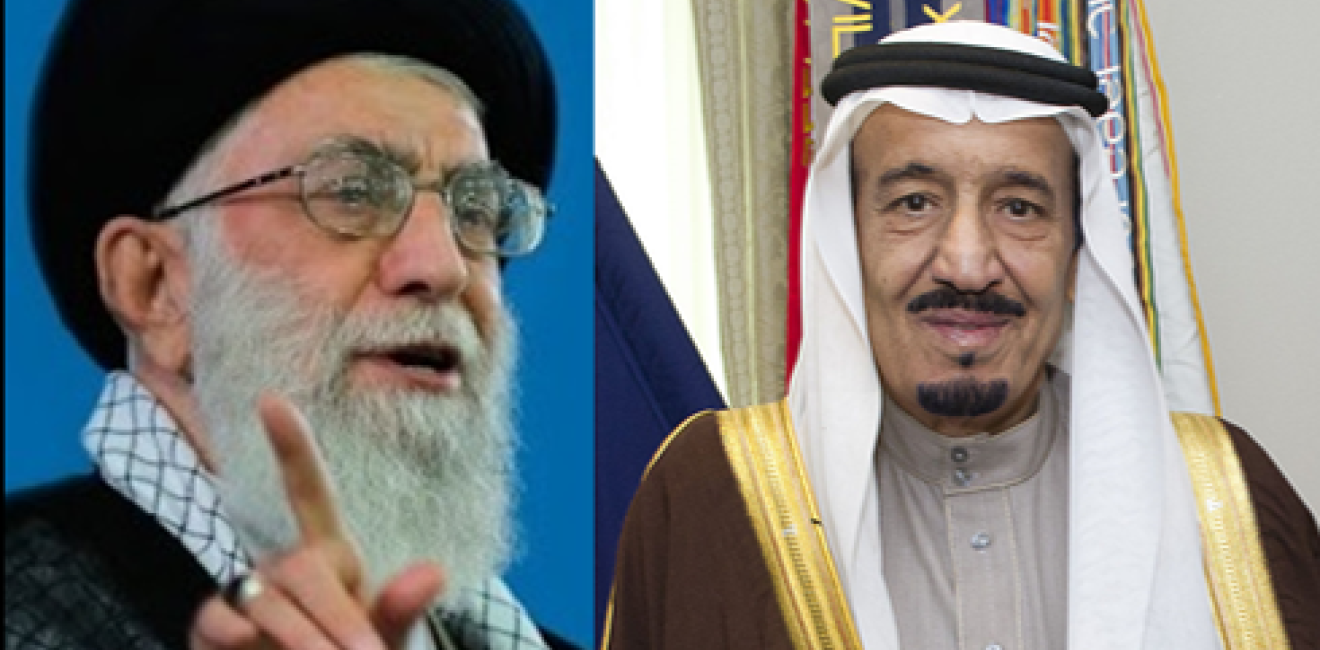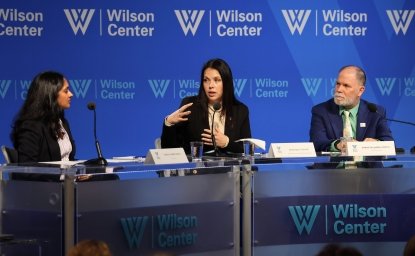By Cameron Glenn

Iran and Saudi Arabia have been regional rivals for more than 30 years, but they have at least one thing in common: Both present themselves as pure, idealized states based on Islam. In practice, however, their unique blends of religion and politics are starkly different.
Iran is a predominantly Shiite theocracy; Saudi Arabia is a predominantly Sunni monarchy. Both award significant powers to their political leaders, but clerics have disparate roles—reflecting the core difference that led to Islam’s original schism 14 centuries ago.
Iran blends democratic and religious institutions because Shiites believe the clergy is empowered to interpret God’s word. Iran’s supreme leader has the last word on political life. Saudi Arabia is an absolute monarchy legitimized by Wahhabi clerics, but the clerics only have advisory roles. The king has the last – and only—word on political life.
The rivalry between Iran and Saudi Arabia has played out on political, social, and cultural levels. Relations were strained throughout the 1980s, as Saudi Arabia quietly supported Iraq during the Iran-Iraq war. The Arab Spring in 2011 further aggravated tensions – Saudi Arabia sent troops to quell the Shiite protests in Bahrain and blamed Iran for provoking the unrest. In September 2015, hundreds of Iranians were killed in a stampede during the annual hajj ritual in Saudi Arabia. Tehran accused Riyadh of mismanagement, and Saudi officials accused Iran of playing politics in the aftermath of the tragedy. And after Saudi Arabia executed Shiite cleric Nimr al Nimr in January 2016, protesters attacked the Saudi embassy in Tehran. As a result, Saudi Arabia severed diplomatic ties with Iran.
By late 2015, both countries were also on the brink of potentially tumultuous transitions. In Iran, President Hassan Rouhani began expanding Iran’s outreach to the world in the wake of the nuclear deal in July, provoking a backlash from hardliners seeking to preserve the revolutionary character of the state. In Saudi Arabia, King Salman removed his brother as his successor and replaced him with a younger prince, placing the kingdom’s future in the hands of the next generation of royals.
Politics
In Iran, the theocracy strongly rejects monarchies. In 1979, Ayatollah Ruhollah Khomeini called for overthrowing pro-American monarchies in the Gulf, including the Saudi kingdom. Saudi Arabia is home to the two holiest cities in Islam, and the formation of the Islamic Republic – an alternative model of Islamic governance, involving elections – challenged Saudi dominance in the Muslim world.
In the Islamic Republic of Iran, the experiment with Islamic governance began with the 1979 revolution. Its republican constitution draws on French and Belgian law but also stipulates that all laws must be compatible with Sharia. Since Shiism awards clerics the authority to interpret between God and man, clerics hold powerful positions in government. Each of the traditional branches of government—the presidency, legislature and judiciary—is mirrored by a parallel institution made up of clerics and Islamic scholars who act as a check-and-balance. The core political debate inside Iran often plays out over which should be more powerful—the republican institutions or the Islamic bodies.
The Kingdom of Saudi Arabia was formed in 1932 after founder Abdul Aziz Ibn Saud seized distant oases and consolidated rival tribes. He unified much of the Arabian Peninsula by winning support from Wahhabi clerics, who offered legitimacy to the House of Saud’s absolute monarchy. The al Saud alliance with Wahhabis – followers of an ultra-conservative version of Sunni Islam – dates to the eighteenth century. The Quran and the Sunnah (sayings and teachings of the Prophet Mohammed) act as the kingdom’s constitution. But in 1992, King Fahd issued the “Basic Law of Governance” with constitution-like principles outlining government roles and responsibilities.
Laws and Courts
Iran and Saudi Arabia claim to base their court systems on Islamic principles. Both countries have been criticized for restricting civil liberties and engaging in arbitrary arrests and detentions, according to the U.S. State Department. In September 2015, Iran summoned the Saudi charge d’affaires in Tehran to protest Saudi Arabia’s execution of three Iranians for non-violent drug offenses. But the Islamic Republic also issues death penalties for drug crimes, and both countries are on track in 2015 to have their highest execution rates in two decades.
Iran has many layers of civil, criminal, and military courts, and its constitution lays out legal rights for its citizens. An additional layer of Islamic courts allows for prosecution and imprisonment on vague charges of anti-Islamic behavior. Iran’s republican constitution promises a wide range of personal and political freedoms, but international watchdogs have documented decades of human rights violations, economic corruption, and social discrimination. Lengthy detentions without charges are common. The penal code permits traditional Islamic punishments, such as stoning, flogging, and amputation. Iran has the second-highest execution rate in the world, after China. Iran executed at least 289 people in 2014. More than 800 people were executed between January and October 2015 alone.
Saudi Arabia also has a network of civil and criminal courts, which issue rulings based only on Sharia. But judges have unparalleled flexibility in judgments and punishments since the kingdom has no formal penal code and individuals have few specified rights. Saudi violations of due process, arbitrary arrests, and torture are common and widely documented. Saudi authorities have imprisoned human rights activists and political dissidents for peaceful activities. Saudi Arabia ranks third in executions – right below Iran – with 90 total executions carried out in 2014. At least 151 people were executed between January and November 2015, according to Amnesty International.
Women
In 2014, Iranian President Hassan Rouhani said, “Women must enjoy equal opportunity, equal protection, and equal social rights.” Saudi Foreign Minister Adel al Jubeir claimed in 2015 that “Women in Saudi Arabia are way ahead of women in other developing countries.” But Iranian women still face political, social, and economic discrimination. And Saudi women face even greater restrictions in public life than Iranian women.
In Iran, the constitution lays out rights and protections for women. They vote, run for office, hold high-ranking political positions and can pursue careers in most professions. Iranian women have won international recognition, from the Nobel Peace Prize to awards at the Cannes Film Festival. They do not need a man’s legal permission to make major life decisions. But women face discrimination in family matters such as marriage, divorce, inheritance, and child custody. Iran’s penal code also stipulates punishment for women who do not fully comply with modest Islamic dress, but many women push the limits with loose and colorful hijab and short, body-clinging jackets.
In Saudi Arabia, women are considered legal minors throughout their lives. They need legal permission from the main male in their life – whether father, husband, brother or son—for all major life decisions as well as for advanced education, employment outside the home, and travel. Women are totally banned from some ordinary public activities, such as driving. They were granted the right to vote in 2015, but gender segregation norms still largely prevent them from exercising this right. A 2013 royal decree granted women the right to serve on the Shura Council, an advisory body to the king. But, in practice, few women hold government office and employment rates are low, despite growing numbers of university graduates.
Judges rely heavily on strict interpretations of Sharia in their rulings. As in Iran, women face greater restrictions than men in matters of marriage, divorce, and custody. Saudi Arabia does not have formal laws on women’s dress. But religious police reprimand women for not wearing proper Islamic clothing, including a headscarf and abaya, a loose-fitting black cloak that covers the entire body.
Religious Minorities
Religious minorities in both countries face various forms of discrimination, which has at times highlighted sectarian tensions between Iran and Saudi Arabia. Tehran has accused Riyadh of encouraging unrest in Iran’s Khuzestan province, which has a large Sunni Arab population. Likewise, Riyadh accused Tehran of supporting the 2012 protests among Shiites in Saudi Arabia’s Eastern Province.
In Iran, the constitution provides for proportionate representation of Christians, Jews, and Zoroastrians in parliament. They all have religious centers, social groups and schools. They are allowed to openly practice their religious rites, including wine for the sacrament, and their holidays. Christmas decorations are a common sight. But religious minorities face discrimination in education and employment. Non-Muslims are not permitted to serve in the judiciary or security services. Most religious minorities are allowed to open schools, but the curriculum is heavily supervised by the Ministry of Education. Sunni Muslims have reported bans on building schools and mosques. Baha’is, Iran’s largest religious minority, have no legal protections and have been the victims of frequent persecution.
In Saudi Arabia, Basic Law identifies Sunni Islam as the state religion. Minorities rarely hold political office, but a few Shiites are members of the advisory Shura Council. The kingdom does not provide explicit protections for minority religions. Minority groups, including Shiites, are not allowed to publicly practice their faith. The kingdom forbids employment of foreign Jews, and foreign Christians in the kingdom are forbidden from either public or private practice of their holidays. It also forbids any non-Muslim from being buried on Saudi soil.
Global Goals
Iran and Saudi Arabia share at least some interests in the Middle East. Both have been significant backers of Palestinian militant groups. Both are also actively engaged in fighting ISIS, and consider themselves vanguards against extremist groups in the region. Saudi Foreign Minister Adel al Jubeir told the U.N. General Assembly in September 2015 that the kingdom is “at the forefront of those countries fighting terrorism from all sides.” That same month, President Rouhani called Iran’s armed forces “the biggest regional power against terrorism.”
But a shared enmity for ISIS is not enough to overcome competition between the two countries for regional influence. Tensions between the two color virtually every conflict in the region. Iran and Saudi Arabia have been exporting their contrasting ideologies and funding different proxy groups for more than three decades.
Tehran aggressively exported its revolutionary ideology in the Islamic Republic’s early days. It promoted Shiism abroad by funding sympathetic Shiite clerics in the Arab world and South Asia. It fostered, armed and trained overt militias and covert operatives, primarily through the Revolutionary Guards. Iran is estimated to have spent hundreds of millions of dollars aiding and abetting groups, from Lebanon’s Shiite Hezbollah to the Palestinians’ Sunni Hamas and a wide array of Iraqi militias. Iran is a strong ally of Syrian President Bashar al Assad, and has sent substantial financial and military support to the regime since 2011. For decades, the State Department has named Iran as one of the world’s top sponsors of terrorism.
Riyadh began funding Wahhabi missionaries, mosques, and schools throughout the Muslim world in the 1980s, in part to counter the Islamic Republic’s influence. By some estimates, Saudi Arabia has spent at least $100 billion promoting Wahhabism since the 1980s. Saudi funds have been channeled to Sunni militant groups abroad, including Hamas, al Qaeda, and the Taliban, according to a U.S. Embassy cable. Extremist groups have been known to gain access to Saudi-based charities that operate with little oversight from the government, diverting funds to support their operations.
Saudi Arabia considers itself a key defender of Muslims and Arabs around the world. The kingdom began launching airstrikes against Yemen’s Houthi rebels in March, and it is among the largest supporters of Sunni rebels in Syria.
Flashpoints
United States
Iran and Saudi Arabia have disparate relationships with the United States.
Washington and Tehran established ties in the 1880s; Iran became one of two pillars of U.S. policy during the Pahlavi dynasty. After the 1979 revolution, Iranian students twice seized the American embassy. Washington severed diplomatic ties in 1980 after the second takeover resulted in prolonged captivity for 52 diplomats. Over the years, the United States imposed an escalating series of sanctions on Iran over its nuclear program, human rights abuses, and support for terrorist groups. The historic nuclear deal in 2015 raised hopes of improving relations, although President Hassan Rouhani cautioned that restoring ties “isn’t going to happen overnight.”

Riyadh has had diplomatic relations with the United States since 1940. And since 1979, the kingdom has replaced Iran as a key pillar of U.S. policy in the region. “Saudi Arabia’s unique role in the Arab and Islamic worlds, its possession of the world’s largest reserves of oil, and its strategic location make its friendship important to the United States,” according to the State Department. In early 2015, Saudi Foreign Minister Adel al Jubeir said no one should “underestimate the strength and depth of relations between the United States and Saudi Arabia.” The United States is Saudi Arabia’s largest trading partner, and the two countries have a long history of security cooperation. Saudi Arabia imports more U.S. arms than any other country, reaching $90 billion in weapons deals between 2010 and 2015.

Syria
Tehran and Riyadh both oppose ISIS, but they support different actors in Syria’s civil war.

Iran has sent military advisors, equipment, and billions of dollars in aid to support Bashar al Assad's regime since 2011. The Islamic Republic has also been critical of U.S.-led airstrikes against ISIS. In September 2015, President Rouhani said “If we want to fight terrorists in Syria, we cannot do so while weakening the central government in Damascus.” Assad and his clan are Alawites, a branch of Shiite Islam, while the majority of Syrians are Sunnis.
Saudi Arabia funds Syria's Sunni rebels fighting Assad, including the U.S.-backed Free Syrian Army. In 2013, it surpassed Qatar as the largest backer of Syrian rebel groups. It joined the U.S.-led coalition against ISIS in 2014. Foreign Minister Adel al Jubeir said in September 2015 that a political solution has “no room for Bashar al Assad or those whose hands have been stained by the blood of the Syrian people.”
In October 2015, Iran accepted an invitation to join Syria peace talks in Vienna with more than a dozen other counties - including Saudi Arabia. The invitation, backed by the United States, marked a major change after two earlier failed peace initiatives in 2012 and 2014. Saudi Foreign Minister Adel al Jubeir said it would be an opportunity to "test Iran's intentions." Iran's Chief of Staff of the Armed Forces Hassan Firouzabadi called Saudi Arabia's participation "suspicious and illegitimate." At the talks, tensions between the two countries were palpable -- the delegations were even seated far apart at the negotiating table in such a way that they could avoid making eye contact.
Yemen
Iran and Saudi Arabia have clashed over the conflict in Yemen. The Houthis, a Zaydi Shiite movement frustrated with their poor political and economic status, took over large parts of Yemen in 2014 and forced out President Abd Rabbuh Mansour Hadi. The Houthis have been fighting Yemen’s government since 2004.

Iran is widely believed to back the Houthis, though the extent of their support is disputed. Tehran has denied providing arms or training to the Houthis, but some Iranian officials have expressed support for the Houthis’ cause. Houthi spokesman Mohammad Abdul Salam said in March 2015 that “Iran’s stance has been positive and the country has supported the Yemeni people.”
Saudi Arabia strongly opposes the Houthis and seeks to restore Hadi’s government. In March 2015, the kingdom began a bombing campaign against the Houthis to dislodge them from power. Saudi Foreign Minister Adel al Jubeir commended the Saudi campaign for “liberating numerous areas from the grip of insurgents” in September 2015. He also accused Iran of “trying to escalate the crisis in Yemen through incitement and attempts to smuggle arms to the rebels.”
Tehran has harshly criticized the Saudi bombing campaign. Secretary of the Supreme National Security Council Ali Shamkhani called the bombings a “war crime.” On the sidelines of the U.N. General Assembly in September 2015, President Rouhani said that Riyadh “should not have had the right to interfere in Yemen’s internal problems.”
Israel and Palestinians
Neither Iran nor Saudi Arabia has diplomatic ties with Israel, and both have separately supported Palestinian militant groups.

Allies under the shah, Iran and Israel ended relations after the 1979 revolution. Tensions between them reached new heights in 2010 over Iran’s advancing nuclear program, and Israeli Prime Minister Benjamin Netanyahu has been an outspoken critic of the nuclear deal reached between Iran and the world’s six major powers. Iran trained and equipped Lebanon’s Hezbollah in the 1980s. It has also provided military aid to Hamas. But relations have been strained since 2011, when Hamas began backing Sunni rebels in Syria’s civil war.
Saudi Arabia has never formally recognized the state of Israel and has reportedly sent more than $480 million in aid to the Palestinian Authority since 2002. Saudi Arabia introduced the Arab Peace Initiative at the 2002 Arab League summit, which proposed a two-state solution. Foreign Minister Adel al Jubeir called for addressing the “continued suffering of the Palestinian people, who are still deprived of their right to live in dignity, in defiance of the principles of international law and resolutions of international legitimacy” during his speech at the 2015 U.N. General Assembly. Although the kingdom’s ties to Hamas have been strained in the past, Hamas leaders visited King Salman in Riyadh in July 2015, signaling a potential shift.
Nonetheless, Saudi Arabia and Israel have some common interests. Both are U.S. allies, and both are wary of Iran’s influence in the Middle East. Rumors have circulated that the two countries have held secret meetings and exchanged intelligence over the past few years.
This piece is part of a four-part series on Iran and Saudi Arabia.
- Part 1: Islam's Arch Rivals
- Part 2: Government & Ideology
- Part 3: Leadership
- Part 4: Women & Minorities
Photo credits: Imam Khomeini via Instagram; Ibn Saud via Wikimedia Commons [public domain]; Kerry and Jubeir by U.S. Department of State via Flickr Commons;
Cameron Glenn is assistant editor of "The Islamists" and a senior program assistant at the U.S. Institute of Peace.
Source: OPEC; CIA World Factbook on Iran and Saudi Arabia
Iran | Saudi Arabia |
Population: 81.8 million Median age: 28.8 years Religion: 99.4% Muslim, 90-90% Shiite and 5-10% Sunni Area: 1.65 million sq km GDP per capita: $17,100 GDP: $404.1 billion Proven crude oil reserves: 157 billion barrels Crude oil production: 3.1 million barrels per day (2014) Crude oil exports: 1.1 million barrels per day (2014) | Population: 27.8 million Median age: 26.8 years Religion: 85-90% Sunni and 10-15% Shiite Area: 2.15 million sq km GDP per capita: $52,200 GDP: $752.5 billion Proven crude oil reserves: 266.6 billion barrels Crude oil production: 9.7 billion barrels per day (2014) Crude oil exports: 7.1 billion barrels per day (2014) |
Author

The Islamists
Learn more about Hamas and how it relates to similarly aligned organizations throughout the region. Read more

Explore More
Browse Insights & Analysis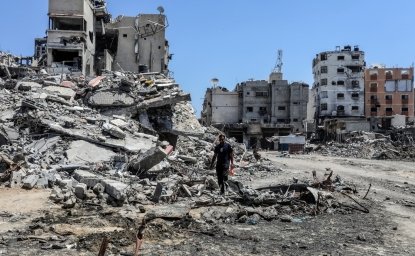
Israel Escalates Attacks in Gaza: What’s Next?
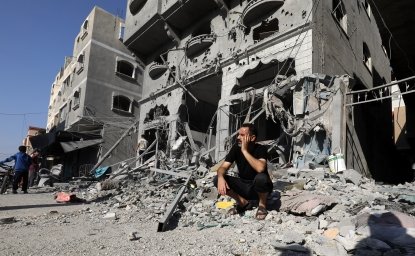
Israel Expands Operations on Multiple Fronts: Perspectives on the Conflict
